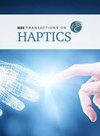TexSenseGAN: A User-Guided System for Optimizing Texture-Related Vibrotactile Feedback Using Generative Adversarial Network
IF 2.4
3区 计算机科学
Q2 COMPUTER SCIENCE, CYBERNETICS
引用次数: 0
Abstract
Vibration rendering is essential for creating realistic tactile experiences in human-virtual object interactions, such as in video game controllers and VR devices. By dynamically adjusting vibration parameters based on user actions, these systems can convey spatial features and contribute to texture representation. However, generating arbitrary vibrations to replicate real-world material textures is challenging due to the large parameter space. This study proposes a human-in-the-loop vibration generation model based on user preferences. To enable users to easily control the generation of vibration samples with large parameter spaces, we introduced an optimization model based on Differential Subspace Search (DSS) and Generative Adversarial Network (GAN). With DSS, users can employ a one-dimensional slider to easily modify the high-dimensional latent space to ensure that the GAN can generate desired vibrations. We trained the generative model using an open dataset of tactile vibration data and selected five types of vibrations as target samples for the generation experiment. Extensive user experiments were conducted using the generated and real samples. The results indicated that our system could generate distinguishable samples that matched the target characteristics. Moreover, we established a correlation between subjects' ability to distinguish real samples and their ability to distinguish generated samples.TexSenseGAN:一个使用生成对抗网络优化纹理相关振动触觉反馈的用户导向系统。
振动渲染对于在人-虚拟物体交互中创造逼真的触觉体验至关重要,例如在视频游戏控制器和VR设备中。通过根据用户动作动态调整振动参数,这些系统可以传递空间特征并有助于纹理表示。然而,由于参数空间大,产生任意振动来复制真实世界的材料纹理是具有挑战性的。本文提出了一种基于用户偏好的人在环振动生成模型。为了使用户能够轻松控制具有大参数空间的振动样本的生成,我们引入了一种基于微分子空间搜索(DSS)和生成对抗网络(GAN)的优化模型。使用DSS,用户可以使用一维滑块轻松修改高维潜在空间,以确保GAN可以产生所需的振动。我们使用一个开放的触觉振动数据集训练生成模型,并选择了五种类型的振动作为生成实验的目标样本。使用生成的和真实的样本进行了大量的用户实验。结果表明,该系统能够生成与目标特征相匹配的可识别样本。此外,我们建立了受试者区分真实样本的能力与他们区分生成样本的能力之间的相关性。
本文章由计算机程序翻译,如有差异,请以英文原文为准。
求助全文
约1分钟内获得全文
求助全文
来源期刊

IEEE Transactions on Haptics
COMPUTER SCIENCE, CYBERNETICS-
CiteScore
5.90
自引率
13.80%
发文量
109
审稿时长
>12 weeks
期刊介绍:
IEEE Transactions on Haptics (ToH) is a scholarly archival journal that addresses the science, technology, and applications associated with information acquisition and object manipulation through touch. Haptic interactions relevant to this journal include all aspects of manual exploration and manipulation of objects by humans, machines and interactions between the two, performed in real, virtual, teleoperated or networked environments. Research areas of relevance to this publication include, but are not limited to, the following topics: Human haptic and multi-sensory perception and action, Aspects of motor control that explicitly pertain to human haptics, Haptic interactions via passive or active tools and machines, Devices that sense, enable, or create haptic interactions locally or at a distance, Haptic rendering and its association with graphic and auditory rendering in virtual reality, Algorithms, controls, and dynamics of haptic devices, users, and interactions between the two, Human-machine performance and safety with haptic feedback, Haptics in the context of human-computer interactions, Systems and networks using haptic devices and interactions, including multi-modal feedback, Application of the above, for example in areas such as education, rehabilitation, medicine, computer-aided design, skills training, computer games, driver controls, simulation, and visualization.
 求助内容:
求助内容: 应助结果提醒方式:
应助结果提醒方式:


